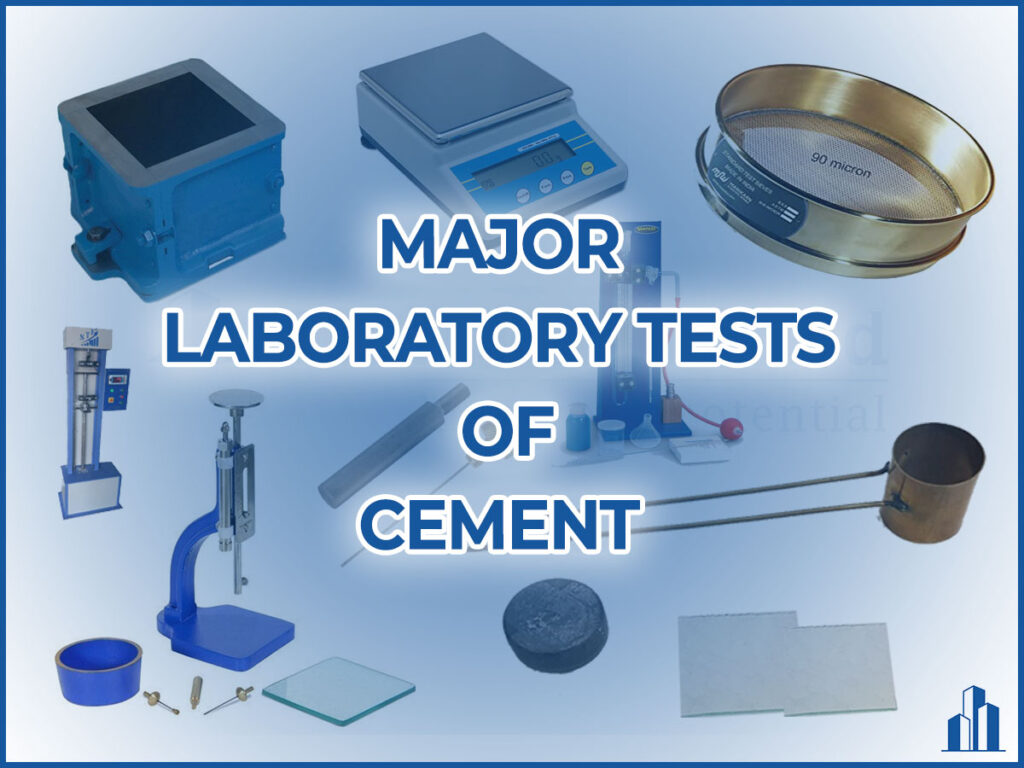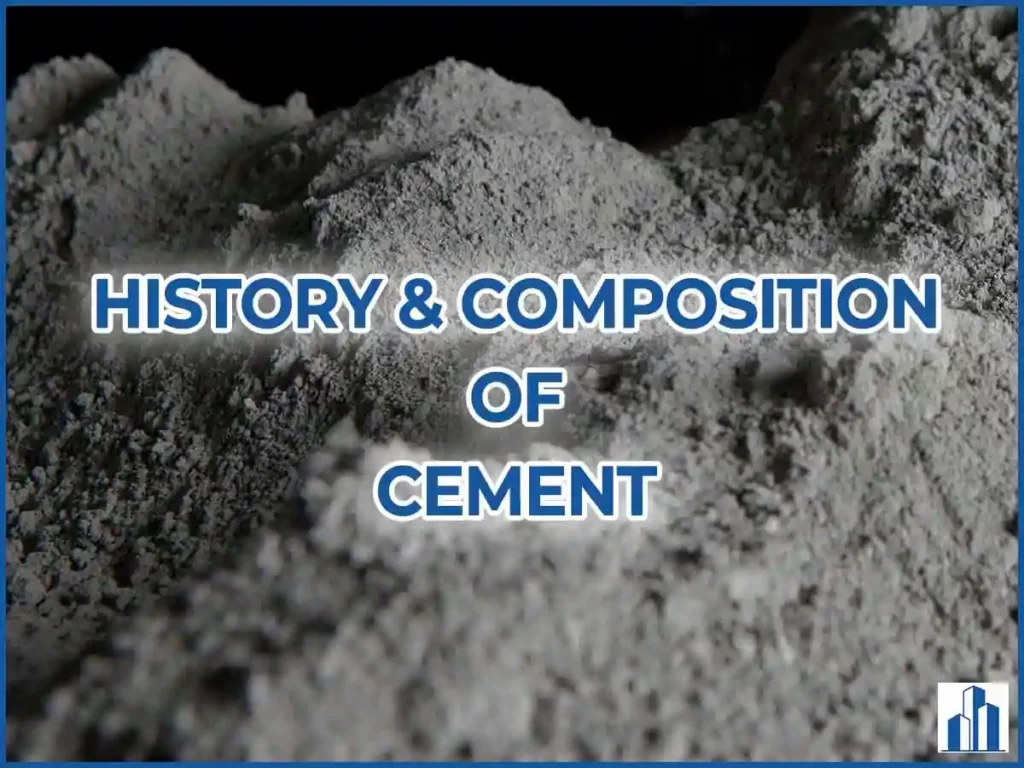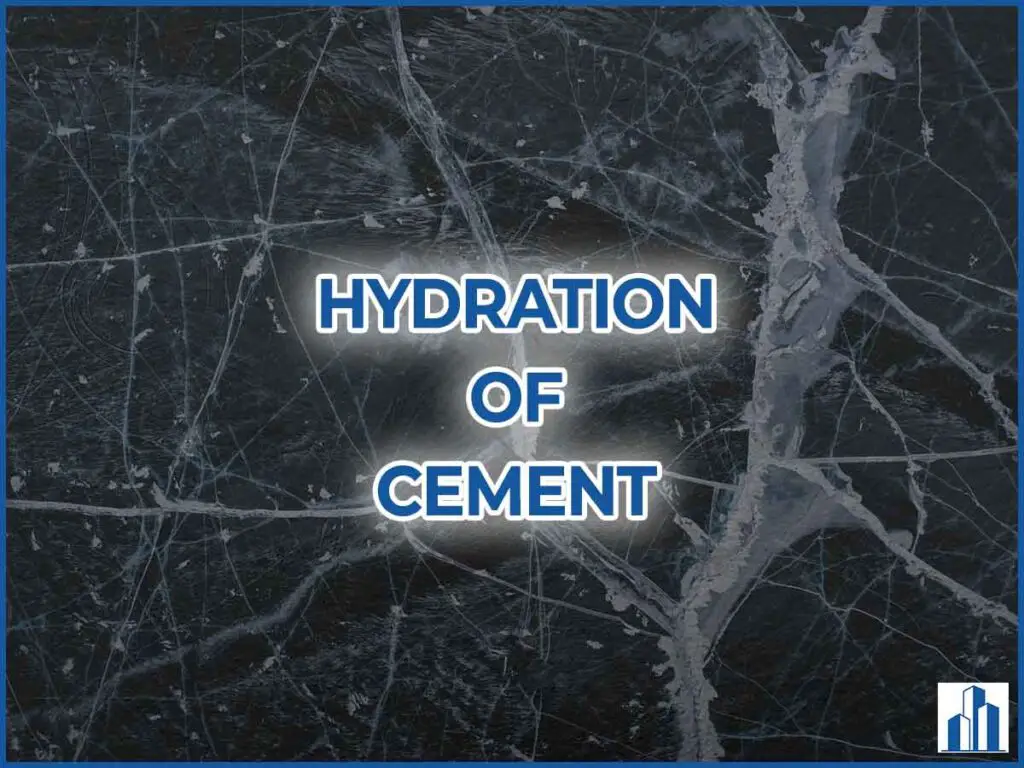Cement is one of the most widely used building materials in the construction industry.
For using cement in important and major works, it is necessary for the user to test the cement in the laboratory to confirm the requirements of the Indian Standard specifications for its physical and chemical properties.
Some of the major laboratory tests of cement are mentioned below.
1. Fineness test of cement
The fineness of cement is nothing but a measure of the particle size distribution of cement and it is expressed in a term called Specific Surface Area (SSA).
The fineness of cement has an important effect on the rate of the heat of hydration developed and also affects the rate of strength development.
The fineness of cement can be determined by two tests,
- Sieve test
- Blaine’s Air permeability test
A. Sieve test
Aim
To determine the fineness of the cement using IS sieve apparatus.
Apparatus required
- 90 micron IS sieve (IS sieve no: 9)
- Weight balance

Procedure
- Take 100g of cement and break the small lumps and place it in the 90-micron sieve
- Sieve the sample continuously for 10 minutes by giving circular and vertical motion
- Note the weight of the cement residue which is left on the sieve
Observations
As per IS recommendations,
- For Ordinary Portland Cement – The residue should not be more than 10%
- For Rapid Hardening Portland Cement & Low Heat cement – The residue should not be more than 5%.
B. Blaine’s air permeability test
Aim
To determine the fineness of the cement and express it as SSA using Blaine’s air permeability apparatus.
Apparatus required
- Blaine’s air permeability apparatus confining to IS:5516
- Weigh balance
- Stopwatch

Procedure
- Weigh about 2.84g of cement and Put it into the cell with a filter paper up and below.
- Compress the cell tightly using a plunger.
- Attach the cell on the top of the manometer.
- Evacuate the air in the manometer through the pressing bulb until the oil level reaches level 1.
- Now closely monitor the oil as it starts to fall down.
- Using a stopwatch, measure the time taken for the oil to fall from level 2 to level 3.
Observations
- Blaine = K√t where K = 523.0547.
- For example, if the time taken = 19 sec, then Blaine’s SSA = 523.0547* K√19 = 2280 cm2/g.
Minimum specific surface area for various cement is mentioned in the below table.
| Types of cement | Minimum specific surface area |
| Ordinary Portland Cement | 2250 cm2/g |
| Portland Pozzolanic Cement | 3000 cm2/g |
| Rapid hardening Portland cement | 3250 cm2/g |
| Low heat Portland cement | 3200 cm2/g |
2. Standard consistency test of cement
Standard consistency is the consistency of the cement paste that will permit a Vicat’s plunger to penetrate a depth of 33 – 35 mm from the top (or) 5 – 7mm from the bottom of the Vicat’s mold.
Standard consistency is used in finding out the initial setting time, final setting time, and soundness of cement.
Standard consistency is sometimes also referred to as Normal consistency of cement.
Aim
To find out the percentage of water required to produce a cement paste of standard consistency.
Apparatus required
- Vicat’s Apparatus with Plunger of 10mm diameter and 50mm length
- Trowel
- Weigh balance

Procedure
- Take 500g of cement and make a cement paste with some quantity of water (say that 24% by weight of cement) for the first trial.
- Quickly fill the mold with the prepared cement paste and allow the plunger to drop on the cement paste. Note the penetration reading of the plunger.
- Now repeat the same above process with different water content (say 26% by weight of cement).
- Keep the trials going on until you reach the penetration depth of 33 – 35 mm from the top. The water content at which you reach the above penetration is called as Basic Water content and is mentioned as P.
Observations
Generally, the water content required to form a paste of standard consistency is in the range of 30 – 35% (Avg 33%).
Note that this test is required to be conducted at a constant temperature (27° + 2°C) and constant humidity (90%).
3. Initial setting time test of cement
Initial setting time is regarded as the time elapsed between the moment that the water is added to the cement, to the time that the paste starts losing its plasticity.
Aim
To find out the initial setting time of cement using Vicat’s apparatus
Apparatus required
- Vicat’s Apparatus with a needle of 1mm diameter and 50mm length
- Trowel
- Weigh balance
- Stopwatch

Procedure
- Take 500g of cement and make a cement paste with 0.85 times the water which is used to create a standard consistency (0.85P).
- Start the stopwatch at the moment when water is added to the cement paste.
- Quickly fill the cement paste into the mold and drop the Vicat’s needle.
- At first, the needle may go up to the full depth of the bottom but as time goes on the cement paste loses its plasticity and create resistance to the needle penetration.
- Drop the needle again after some time until the needle may penetrate only to a depth of 33-35 mm from the top.
- The period elapsing between the time when water is added to the cement and the time at which the needle penetrates the block to a depth equal to 33-35 mm from the top is taken as the initial setting time of cement.
Observations
According to IS 456, the initial setting time should be a minimum of 30mins. This 30mins is given for mixing and handling operations at the site.
Note that this test is required to be conducted at a constant temperature (27° + 2°C) and constant humidity (90%).
4. Final setting time test of cement
The final setting time is the time elapsed between the moment the water is added to the cement and the time when the paste has completely lost its plasticity and has attained sufficient firmness to resist certain definite pressure.
Aim
To find out the final setting time of cement using Vicat’s apparatus
Apparatus required
- Vicat’s Apparatus with a needle of 1mm diameter and 50mm length with a circular attachment of 5mm in diameter. The needle is projected 0.5mm outward than the circular attachment.
- Trowel
- Weigh balance
- Stopwatch

Procedure
- The sample which we prepared for the initial setting time can also be used as a sample for this test. If we want, we can prepare individual samples too.
- Release the Vicat’s needle with a circular attachment on the sample.
- Note the impression which the needle makes on the sample.
Observations
The cement shall be considered as finally set when, upon, lowering the attachment, the center needle makes an impression, while the circular cutting edge of the attachment fails to do so.
In other words, the paste has attained such hardness that the center needle does not pierce through the paste more than 0.5 mm.
Normally, the final setting time of cement will be 10 hrs (600mins).
The initial and final setting times of different types of cement are mentioned in the table below.
| Types of cement | Initial setting time | Final setting time |
| Ordinary Portland Cement | 30 mins | 10 hrs |
| Portland Pozzolanic Cement | 30 mins | 10 hrs |
| Rapid hardening Portland cement | 30 mins | 10 hrs |
| Low heat Portland cement | 60 mins | 10 hrs |
| Masonry cement | 90 mins | 1 day |
| Quick setting time | 5 mins | 30 mins |
4. Soundness test of cement
The term soundness in cement indicates its resistance against volumetric change. It is very important that the cement after setting shall not undergo any appreciable change in volume. If it undergoes any volumetric change, it will result in the deterioration of hardened mass and leads to many serious durability issues.
Unsoundness in cement may be caused due to,
- Excess of lime
- Excess of magnesia
- Excess of Sulphates
Aim
To find out the soundness of cement using Le chatelier’s apparatus
Apparatus required
- Le chatelier’s apparatus – It is an apparatus that consists of a small split cylinder of brass or other suitable metal. It is 30 mm in diameter and 30 mm high. On two sides of the split, two indicator arms of 165mm are attached.
- Trowel
- Weigh balance
- Glass plate
- Weights

Procedure
- Make a cement paste with 0.78 times the water which is used to create a standard consistency (0.78P).
- Fill it into the mold and cover the top and bottom of the mold using a glass plate. Now place the entire setup with a small weight on top of it, under the water at a temperature of 27°C, and kept there for 24 hours.
- After 24 hrs, take the setup and measure the distance between the indicator arms.
- Now submerge the mold again and heat the water and bring the water to the boiling point in about 20-30 minutes. Keep the water boiling for 30 mins.
- Now again take the setup and allow it to cool. After cooling, measure the distance between indicator arms.
- The difference in distance is termed as the expansion of the cement.
Observations
The maximum limit of the expansion for different types of cement is mentioned below.
| Types of cement | Max Le chatelier’s expansion |
| OPC, RHPC, LHC, PPC, Slag cement, SRC | 10 mm |
| High Alumina cement, Super sulphated cement | 5 mm |
Limitations
- The Le chatelier’s apparatus can find unsoundness only due to excess lime only.
- Unsoundness due to excess of magnesia can be found out by the Autoclave test.
- No test can find the unsoundness of cement due to excess of sulphate, but it can be easily identifiable by chemical analysis.
5. Compressive strength test of cement
The compressive strength of the hardened cement is one of the most important of all the other properties. The specimen for the strength test is not only made up of cement because of difficulties of excessive shrinkage and cracking. Instead, we use a specimen which is made up of cement and sand. The strength of cement is indirectly found on cement sand mortar cubes.
Aim
To find out the compressive strength of cement using a cement mortar cube.
Apparatus required
- Cube mold of size 7.06 cm
- Trowel
- Weigh balance
- Compressive Testing Machine

Procedure
- Take cement and mix it with a standard sand in a ratio of 1:3. Then add the water of quantity P/4 + 3% of the combined weight of sand & cement.
- Mix the ingredients thoroughly. The mixing time shall not be less than 3 mins and shall not be greater than 4 mins.
- Immediately after mixing, place the cement mortar into the mold and allow it to cure at the standard temperature and humidity for one day.
- After 24 hrs, take the cement mortar cube and remove the mold and place it in the compressive testing machine.
- Keep on loading until the cement cube reaches failure. The load at which the specimen fails is considered as a compressive strength of that specimen.
- Three cubes are tested for compressive strength and the compressive strength shall be the average of the strengths of the three cubes respectively.
Observations
At the end of 1 day, the cement cube must attain at least 16% of the ultimate strength. If a cement mortar cube passes that number, then it can show that it can be able to attain sufficient strength in the given time.
6. Tensile strength test of cement
Aim
To find out the tensile strength of cement mortar cube using briquette mold.
Apparatus required
- briquette mold
- Weigh balance
- Tensile Testing Machine

Procedure
- Prepare the cement mortar with a ratio of 1 : 3
- Fill into the mold and after letting it cure for one day, test it in the same way as we do for the compressive strength test.
- The average strength of 6 briquette molds is taken as the tensile strength of cement.
Observations
The minimum 1-day tensile strength of cement mortar specimen may be 2 Mpa.
Normally, Tensile strength = 10 to 15% of the compressive strength of a cement mortar cube.
Hope this article gives complete knowledge about the tests of cement performed in the laboratory and if you have any queries leave it in the comment section.
You also might like : Types of cement



